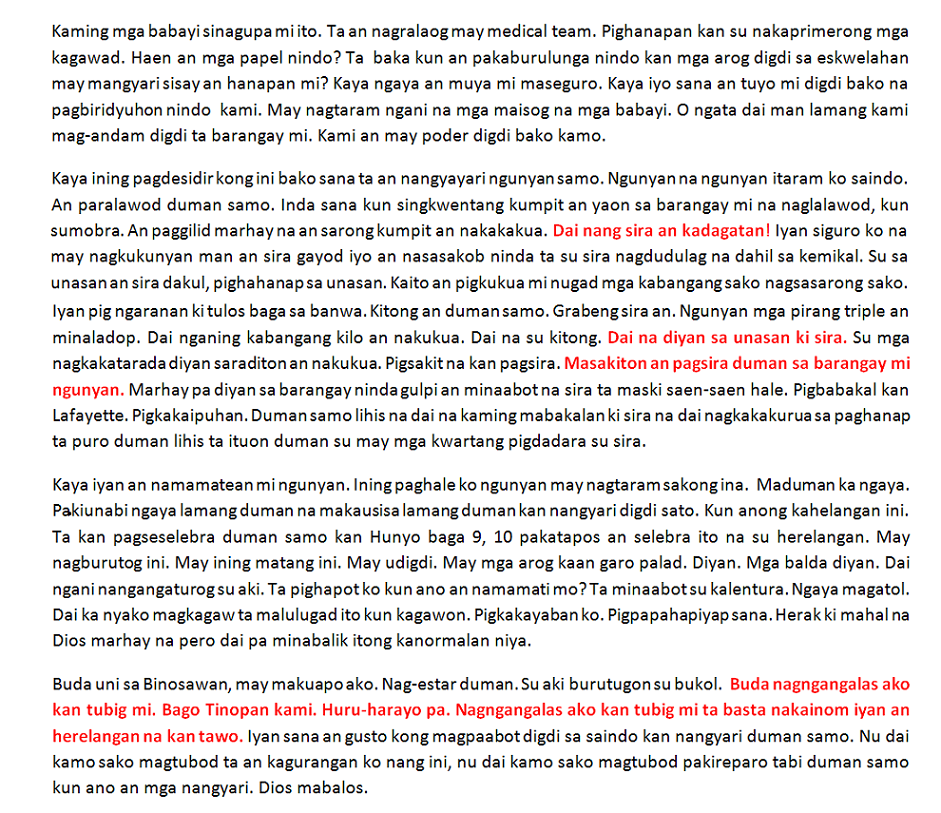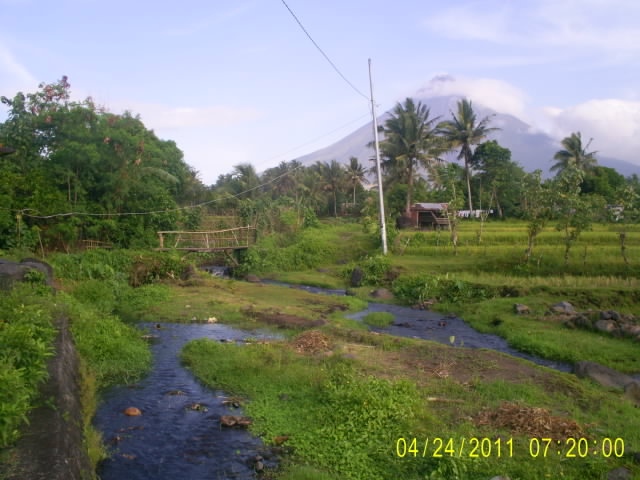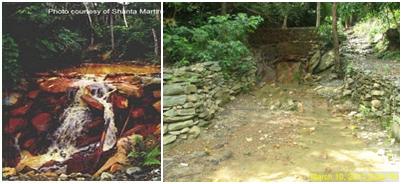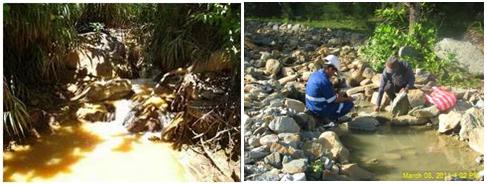So the Inquirer may know.
This is a rejoinder to the PDI news article "Give us jobs, Rapu-Rapu folk challenge militants" (12 December 2007, page A11).
1. “The leaders and residents of Rapu-Rapu in Albay” who released the press statement do not represent the majority opinion in Rapu-Rapu. The phrase and general tone of the article imply that these “leaders and residents” voice the general sentiment in Rapu-Rapu. Not by a mile, or 10 kilometers for that matter.
2. They challenge the militants to help the “poor mining community” find jobs. If Lafayette actually provides them poor mining community-members with viable livelihood, as company officials claim, why do they still remain poor? What about the much bigger and native poor fishing community? What have they got after Lafayette started mining their island? They have gotten poorer.
3. “These outsiders are risking our future and our lives in the name of the environment.” If there is one sentence that may model for being a mix of irony, oxymoron and convoluted logic, this may be it. Now, now, do they mean all those opposed to mining in Rapu-Rapu are only/mainly outsiders? Are they saying the majority of Rapu-Rapu's residents not against Lafayette mining their island? Excuse me, will the real outsiders, please stand up? Baker, Quartermaine, Dominguez, Agabin, Calleja, and the rest of Lafayette’s minions, yes you, all of you.
4. “Their real advocacy is to keep us poor and desperate and we all know why. And they get paid for what they do.” Who they? I’m not sure I know why exactly? But I sure know I don't get paid for what I do. If the people behind the press release want to poise the old “these commies only want to topple the government by agitating the masses” line, fine. I leave it to the leftists to defend themselves and answer that. Then again, the broad alliance of anti-Lafayette groups embraces a wide spectrum of society, including the Church, the academe, NGOs, and many common people. How do they take that to account? Simple: let’s not confuse the masses, just single out the leftists, they’re easy target and it makes for good PR. Unless you haven't been to Rapu-Rapu (I mean the island’s barangays, not the mine site, especially when you’ve only taken the company's sanitized mine tour), and you're blind and deaf, here's an open secret for you: it's Lafayette who's making the island's residents poorer and more desperate.
5. “The militants and even some Church people had resorted to lying to scare the public of non-existent disasters they blame on the project.” They’re so unlike the Lafayette guys who are all honorable men and women.
They promised to bring prosperity to Rapu-Rapu and protect the environment. Then they applied for very generous tax cuts and the 2005 fish kills happened. But they say the tax cuts were all legal and they repented for causing the mine spill and subsequent fish kills, though they still won’t own up to the fish scare. They even came up with a kilometric slogan: “It is better to light a candle for responsible mining than just to curse the darkness of past environmental sins.” For the Lafayette guys are all honorable men and women.
Another round of fish kill incidents happened on 13, 21 and 22 July 2006, well within the 30-day test run. Lafayette officials were quick to cry sabotage and hoax. A company lawyer even went as far as laying the blame on a priest assigned in Rapu-Rapu. The DENR chose to ignore these fish kill incidents and proceeded to permit Lafayette to operate as before. These militants and priests are so unlike the Lafayette and DENR guys who are all honorable men and women.
Lafayette provides jobs for Rapu-Rapu. In May 2007, a company official boasted that they employ a whooping total of 131 Rapu-Rapu locals among their personnel. 131 is less than 0.5% of the town’s total population. Most of these workers splurge on a salary of around P6,000 a month. How generous of the company. How dare these militants and priests take the cudgel for the environment and the rest of the town’s population. Why can’t they be like the Lafayette guys who are all honorable men and women.
The most recent fish kill in Rapu-Rapu was observed from 27 October to 2 November 2007. The people in Poblacion witnessed it. People from other barangays witnessed similar incidents in their places too. The number of food poisoning cases was up not just in Poblacion but in other barangays as well. But the chairs of five barangays declared no fish kill happened in their places. Besides, a Pagcolbon resident, one Mr. Ananias Balato also said so. Lafayette officials said so. And the DENR ever so quickly and obligingly concurred. Why shan’t we not believe them? They are all honorable men and women.
6. Greenpeace has never assumed leadership role among “militant anti-mining groups”. Though I won’t necessary mind if they would. Rather, the anti-Lafayette campaign has been run by a loose alliance of environmentalist groups, both local and international. This is but a minor detail though indicative of lazy and haphazard news gathering and research. And, by the way, Bishop Arturo Bastes is still the Bishop of Sorsogon.
7. “Allegations of mercury contamination were never substantiated and were even declared a hoax by supporters of the mining operation.” Calling all fish kill incidents a hoax and a result of sabotage is now a widely-recognized standard Lafayette excuse. Also it is an observed human trait that when one lies so many times, there comes a point when even the liar believes his own lies.
There were traces of mercury found in fish samples from Prieto Diaz, Sorsogon, that were collected around the same time as the 2005 fish kills in Rapu-Rapu. Ex-Vice-Governor James Calisin of Albay, a staunch mining supporter, requested the NBI to investigate whether that one was a hoax, and publicly announced his move on many occasions, in tones that appear to mock and attempt to threaten anti-Lafayette groups. Until now, the NBI has not publicly identified any alleged hoaxers nor even come out with any report. Yet Lafayette officials have already branded that one a hoax.
Then again, why concentrate only on mercury? What about the presence of cyanide or other toxic chemicals? What about the high acid level of certain bodies of water near the mine site? Why have Lafayette private security personnel and their "subsidized" barangay security personnel maintain a policy of harassing researchers and preventing them from getting soil and water samples even when research is done outside company property?
8. “I live here and I can tell you we had a perfectly normal life until these outsiders started telling the world we had a fish kill.” So allegedly said Pagcolbon resident Mr. Balato (apparently, that’s his real name). First, most residents of Rapu-Rapu, including, I daresay, those who signed the press release, could not honestly say they have been living a perfectly normal life since the mining company started operations on their island. Second, those who reported that fish kill was also sighted in Pagcolbon were also residents of Pagcolbon.
Residents from Binosawan even claimed that fish kill was sighted in their place as early as 26 October 2007. The newly-elected barangay chair of Binosawan, Ms. Nida Bendal, testified that fish kill happened in her barangay, contrary to a so-called certification given by the former barangay chair. In fact, she also claimed Lafayette security personnel were seen in her barangay, collecting dead fish then burying them. She was also among those who actively joined the Kampo ng Bayan in front of the Albay Capitol.
In Malobago, a young boy, about 9 years-old, volunteered to an independent researcher that he saw a Lafayette security guard collecting dead fish and burying them. The young boy’s testimony was recorded on the researcher’s videocam.
Bishop Lucilo Quiambao, Apostolic Administrator of Legazpi, narrates in his pastoral letter: “In one instance, a resident from Brgy. Carogcog, who was interviewed by a team from the (DENR-)EMB, also testified that he saw dead fish littering the shorelines of his barangay. This detail never found its way to the (DENR-)EMB report.”
9. The press release also chided certain priests “who prefer to just stay in the comfort of Lega(z)pi City”. The priests assigned in Rapu-Rapu, current and past, have long journeyed together with their parishioners in their common struggle against large-scale mining on the island. If Bishop Quiambao and the 70-plus clergy, who also affixed their signature, could release a pastoral letter on the recent fish kill, it was, among other things, because they believed in the testimony of the priests and parishioners of the island. The Rapu-Rapu priests’ integrity, lack of personal agenda, and love for their parishioners, are beyond question. Could that be said, too, of the people behind the press release? Why haven’t the Inquirer asked, in the first place, Father Andy Baliwas, SOLT, and Father Jerry Llona, SOLT, the priests currently ministering in Rapu-Rapu, if it wanted some semblance of balance in its article?
10. “Government experts, however, ruled out the project as the cause of a supposed fish kill, which is more than 10 kilometers away.” First, the fish kill really happened. Second, so-called government experts have never really ruled out the project as the cause of the fish kill. They do exhibit a tendency to attempt to hastily absolve Lafayette from any culpability. Yet nowhere in any government report has Lafayette been conclusively discounted as the cause of the recent fish kill.
Third, the DENR-EMB report is hounded by allegations of withholding data perceived to be unfavorable to the mining company. And BFAR is receiving so much flak locally after its officials offered their theories in local radio interviews on how the fish kill might have happened. The more infamous of their theories is the one which had the fish drowning due to strong sea currents and lack of oxygen.
Both Governor Joey Salceda of Albay and Bishop Quiambao find the DENR-EMB report questionable in some of its parts. BFAR until now has yet to publicly release a copy of its report. Yet Lafayette officials bandy about here and abroad the false claim that they have been cleared of any culpability on the recent fish kill by very credible government experts.
As to the contention that the fish kill was too far away from the mine site, Bishop Quiambao chided the DENR-EMB in his pastoral letter for not taking into consideration the direction and speed of the wind and water current at the time of the fish kill. He wrote: “Seasoned fisherfolk and astute observers not only point out this fact, but also how the (DENR-)EMB conveniently took this fact aside.”
Ateneo de Naga University’s INECAR, headed by Dr. Emelina Regis, conducted their own research on the fish kill and concluded, among other things, that: “It was impossible for the source of the poison that killed the fishes to originate from the town proper because of the heavy rains and wind direction (on) 26-27 October 2007. If this (were) the case, the dead fishes (would) have floated farther west of the island. Thus, the poison could have only come from the eastern section of the island.” The mine site is located in that section of the island.
11. The real leaders and representatives of the residents of Rapu-Rapu have already stood up. In fact, they have pitched camp in front of the Albay capitol for a week. They have sought and have been able to get time to talk with the Provincial Board who grudgingly agreed to listen to them. The Board Members have assured them that they would take appropriate action.
The Inquirer wasn’t there. While most, if not all, local media covered the events that unfolded during the Kampo ng Bayan, the Inquirer’s Southern Luzon Bureau wasn’t there. If somebody was there, s/he would have filed a news report. If an Inquirer reporter was there and filed a report, why was it not published?
Apparently, the Inquirer chose to believe they were all “militant outsiders”. The news article mentioned Sagip Isla as among the militant groups present there. The fact: Sagip Isla – Sagip Kapwa , a group composed mainly of Rapu-Rapu residents, was the main organizer of the activity. The group counted a minimum of 350 Rapu-Rapu residents to have participated in that week-long activity. Why did the Inquirer choose not to believe them and instead choose a patently Lafayette-sponsored press release, and then run it on the very last day of the camp? Methinks the article was a ploy to undermine the gains of the Kampong Bayan.
Poetic justice had its way when on the day the Inquirer came up with that press-release-turned-news-story that had Rapu-Rapu residents denouncing the militants and the Church, ABS-CBN’s TV Patrol World ran a video coverage of Sagip Isla members barging inside the Provincial Board’s meeting hall and getting their voices heard not just by the dawdling Board Members but by the entire country (and the world) on national TV.
Some final questions for the Inquirer: Who was the anonymous journalist who wrote that article? Who was/were the editor/s that allowed that piece of yellow journalism to be printed? How green may the Inquirer still claim itself to be?




































































































































